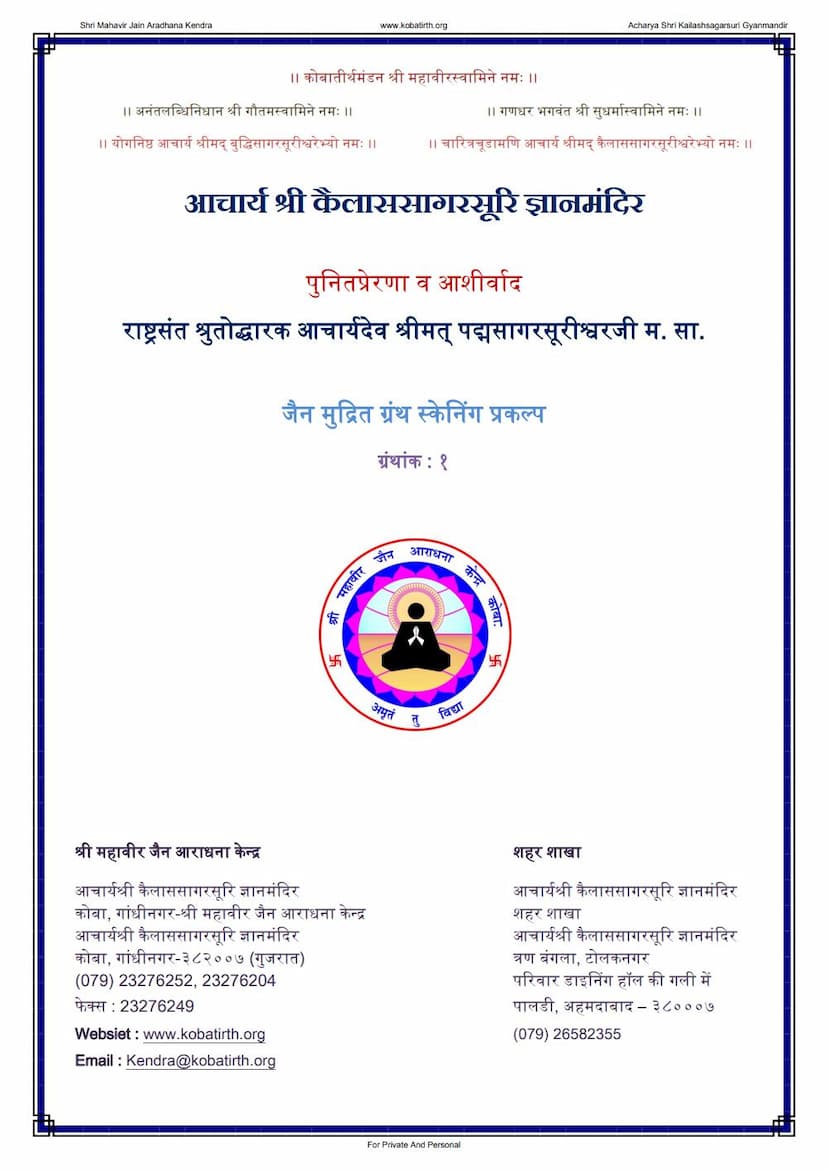Devvandanbhashyam
Added to library: September 1, 2025

Summary
The provided text is the "Devvandanbhashyam" (also referred to as "Shri Devvandan Chaitya Vandan Bhashyam" or "Shri Sanghachara Vidhi") by Acharyas Devendrasuri and Dharmakirtisuri. It is a comprehensive commentary and guide on Jain devotional practices, specifically focusing on Chaitya Vandana (worship of Jain temples and icons) and related rituals.
Here's a summary of the key aspects covered in the extensive text:
1. Purpose and Scope:
- The text aims to provide a detailed explanation of the correct procedures and principles for Chaitya Vandana and other devotional acts in Jainism.
- It draws heavily from established Jain scriptures like the Aavashyak Sutra, Mahanishith Sutra, Uttaradhyayan Sutra, Brihad Bhashya, Churnis, and Niyukti texts, citing them frequently.
- It addresses the requirements for monks, nuns, and lay followers (shravakas and shravikas).
2. Core Concepts of Chaitya Vandana:
- Etymology of Chaitya: The text explores the meaning of "Chaitya," which can refer to the temple itself, the idol, or the foundational principles that give rise to devotion.
- Importance of Chaitya Vandana: It emphasizes the necessity and benefits of Chaitya Vandana for spiritual progress, karma reduction, and achieving liberation (moksha). It highlights that Chaitya Vandana is considered a fundamental daily duty (aavashyak).
- Types of Vandana: The text describes different levels and forms of worship, including:
- Jaghanya (Inferior): Basic worship, possibly involving minimal rituals.
- Madhyama (Intermediate): Standard worship.
- Utkrushta (Superior): Elaborate and devotional worship.
- The Five Blessings: The text implicitly or explicitly refers to the Pancha Paramesthi Namaskar (Homage to the five supreme beings: Arihant, Siddha, Acharya, Upadhyaya, Sadhu) as the foundation of all auspiciousness and a core element of devotion.
3. Detailed Ritualistic Procedures: The text meticulously breaks down the process of Chaitya Vandana and related acts into several "doors" or sections, each covering a specific aspect:
- Mangaladi (Beginning with Auspiciousness): The importance of starting rituals with auspicious greetings and prayers.
- Abhigama (Approach): Rules for entering temples and approaching the idols, including considerations for purity, proper dress, and avoiding certain actions.
- Drishti (Gaze/Direction): Rules regarding where to look during worship, emphasizing facing the deity and avoiding looking in specific directions or at unrelated things.
- Avagraha (Limitation/Space): The prescribed distance and space to maintain while worshiing.
- Vandana (Salutation): Detailed explanations of different types of salutations and prostrations (pranam), including the significant Pancha-anga Pranam (prostration with five limbs touching the ground).
- Mudras (Hand Gestures): Descriptions of specific hand positions like Yoga Mudra, Jina Mudra, and Mukta Shukti Mudra.
- Puja (Worship): Elaborate descriptions of the various components of worship, including:
- Anga Puja: Worship of different parts of the idol.
- Agra Puja: Offering food, fruits, water, incense, lamps, etc.
- Bhava Puja: Internal worship through devotion and contemplation.
- Naishedhiki (Prohibitions): Actions that are forbidden within the temple premises or during worship.
- Kāyotsarga (Standing Still): The practice of standing still in a meditative posture, its regulations, duration, and purpose.
- Stuti (Praise/Hymns): The chanting of praises and hymns (stotras) dedicated to the Tirthankaras and other revered beings. The text includes numerous examples and detailed analyses of various stutis and mantras.
- Pranidhana (Concentration): The importance of focused devotion and meditation during rituals.
- Paramparā (Tradition/Lineage): The text frequently refers to the importance of following the practices established by previous venerable monks (Acharyas) and the tradition passed down through generations.
- Reasons for Practices: The authors often explain the underlying logic or spiritual rationale behind specific rituals and prohibitions.
- Refutation of Other Views: The text also addresses and refutes differing interpretations or practices from other schools of thought where applicable.
4. Illustrative Narratives (Upakhyānas/Stories):
- A significant portion of the text comprises numerous illustrative stories (vṛttānta or kathā) of ancient kings, noble lay followers, and spiritual practitioners. These narratives serve to:
- Demonstrate the practical application of the described principles.
- Highlight the merits of devotion and adherence to Dharma.
- Illustrate the consequences of deviation or misconduct.
- Reinforce spiritual lessons through engaging anecdotes.
- Examples mentioned in the extensive index include stories of Rishabha, Nami-Vinami, Shri Vijaya, Mrigavati, King Shalin, Amittej, Brahmadaatt, Vichitravēga, King Shantinath, King Vikrama, King Naramala, King Sharasamala, Shri Datta, King Kantiśrī, King Śrīgupta, King Ramanaga, King Merurath, King Gunamitra, King Brahmadatta, King Virama, King Kumara, King Kotiśrava, King Dhanaśreṣṭhi, King Rativardhana, King Bhartr̥hari, King Śrīpati, King Śrīṣeṇa, King Anantavīrya, King Vajraśrāvaka, King Meruratha, King Śaraṇa, King Dhanaśrēṣṭhi, King Dhruva, King Śaśin, King Ajita, King Saṅgama, King Candanapati, King Dhanapati, King Saṅgavrata, King Nīla, King Malli, King Neminātha, King Pārśvanātha, King Mahāvīra, King Ṛṣabha, King Śreyānsa, King Vasupūjya, King Vimalanātha, King Śāntinātha, King Kunthu, King Arha, King Malli, King Munisuvrata, King Nemi, King Pārśva, King Mahāvīra, King Ṛṣabha, King Śreyānsa, King Vasupūjya, King Vimalanātha, King Śāntinātha, King Kunthu, King Ara, King Malli, King Munisuvrata, King Nemi, King Pārśva, King Mahāvīra, and King Ṛṣabha, among many others.
5. Detailed Examination of Terms and Concepts:
- The text delves into the nuances of various Jain terms, explaining their meaning, context, and application in rituals. This includes detailed discussions on concepts like kaāyotsarga, pranidhana, samāyika, pauga, prakramaṇa, nisihedhiki, dosas (faults), achara (conduct), and anāchāra (improper conduct).
6. Emphasis on the Tapa Gaccha Tradition:
- The introduction and various references within the text highlight the commentary's origin within the Tapa Gaccha lineage of Śvetāmbara Jainism, mentioning prominent Acharyas like Śrī Devendra Sūri and Śrī Dharmaghosh Sūri.
- The text also engages in discussions and refutations of other monastic traditions or interpretations prevalent at the time.
7. The Importance of Following Authentic Tradition:
- A recurring theme is the emphasis on adhering to the authentic teachings and practices passed down through generations of Jinas (Jain Tirthankaras), Ganadharas (disciples of Tirthankaras), and venerable Acharyas, rather than novel or personal interpretations.
In essence, the "Devvandanbhashyam" is a foundational text for understanding and performing Jain devotional rituals correctly, emphasizing the meticulous adherence to tradition, spiritual intent, and the purification of actions.